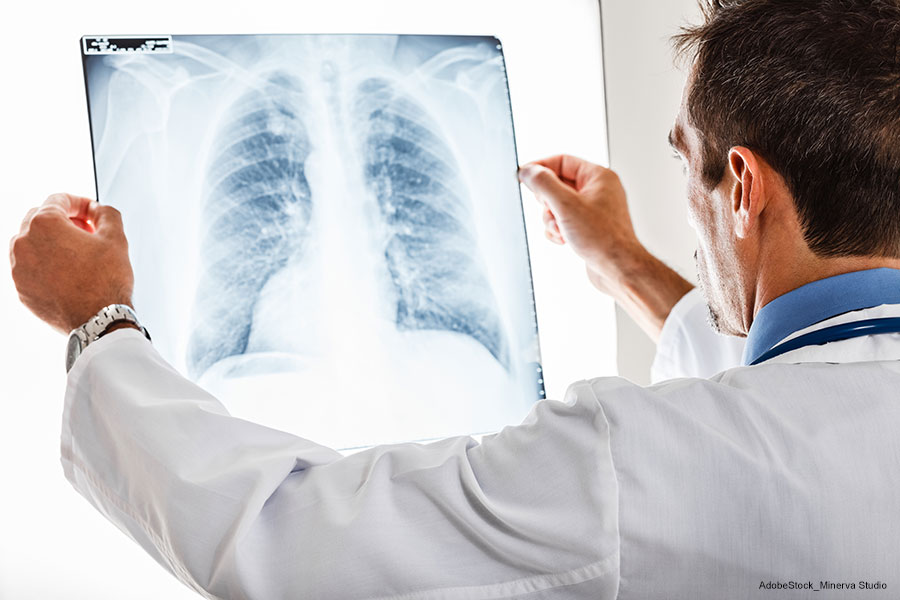 Several clinical scenarios were reviewed by Maria E. Theodorou, MD, FACP, FHM, an associate professor at Northwestern University Feinberg School of Medicine in Chicago, highlighting the clinical practice guidelines from the Infectious Diseases Society of America and the American Thoracic Society for the diagnosis and treatment of adults with community-acquired pneumonia (CAP). Notably, these guidelines do not specifically address sepsis. If a patient meets criteria for a sepsis diagnosis, standard sepsis care protocols—beyond the scope of these guidelines—should be followed accordingly. These guidelines for CAP walk through 16 specific areas for recommendations, many of which were covered during this lecture. Additional topics, such as imaging and molecular assays, were also explored, offering a broader perspective on diagnostic and management strategies beyond the guidelines.
Several clinical scenarios were reviewed by Maria E. Theodorou, MD, FACP, FHM, an associate professor at Northwestern University Feinberg School of Medicine in Chicago, highlighting the clinical practice guidelines from the Infectious Diseases Society of America and the American Thoracic Society for the diagnosis and treatment of adults with community-acquired pneumonia (CAP). Notably, these guidelines do not specifically address sepsis. If a patient meets criteria for a sepsis diagnosis, standard sepsis care protocols—beyond the scope of these guidelines—should be followed accordingly. These guidelines for CAP walk through 16 specific areas for recommendations, many of which were covered during this lecture. Additional topics, such as imaging and molecular assays, were also explored, offering a broader perspective on diagnostic and management strategies beyond the guidelines.
Imaging modalities—including chest X-ray, lung point-of-care ultrasound (POCUS), and chest CT—were reviewed. Although CT remains the gold standard due to its high resolution, its use is limited by cost and radiation exposure. The presenter emphasized the value of lung POCUS, citing its high sensitivity (90% to 98%) and specificity (94% to 99%). However, its broader adoption is hindered primarily by the need for adequate operator training and experience.
Newer molecular assays, such as the BioFire panel, were presented with caution. While their negative predictive values are generally high, their positive predictive values range widely (5% to 100%), which necessitates careful interpretation. Not all relevant pathogens are included in currently available commercial tests, and most validation studies involved patients under ideal conditions, such as the ability to produce high-quality sputum samples.
Routine blood cultures, sputum cultures, and gram stain testing are not recommended for all patients. However, they may be indicated if a patient meets one major criterion or three minor criteria per the Infectious Diseases Society of America-American Thoracic Society CAP severity scoring, is receiving empirical treatment for Pseudomonas aeruginosa or methicillin-resistant Staphylococcus aureus (MRSA), or has a recent hospitalization within 90 days and/or prior intravenous antibiotic use. These recommendations vary from strong to conditional, all based on very low-quality evidence.
Legionella and pneumococcus urinary antigen testing are not routinely recommended except in adults with severe CAP, recent travel, or during a recognized outbreak. Influenza and COVID-19 testing should be performed during periods of regional viral activity, with polymerase chain reaction (PCR) tests preferred over rapid antigen tests due to superior sensitivity. Currently, there is a strong recommendation, supported by moderate-quality evidence, to provide anti-influenza treatment to adults with CAP who test positive for influenza, regardless of the duration of illness prior to diagnosis. Despite a confirmed viral finding, empiric treatment for possible bacterial superinfection or coinfection is also advised, based on a strong recommendation but low-quality evidence, pending completion of a full diagnostic workup.
At this time, serum procalcitonin should not be used to determine whether antibiotics are to be initiated in CAP, but rather can be helpful to decide when empiric antibiotics can be stopped. All adults with clinically suspected and radiographically confirmed CAP should be started on empiric therapy with subsequent monitoring. Procalcitonin of 0.1 μg/L or less indicates a high likelihood of viral infection, and 0.25 μg/L or higher indicates a high likelihood of bacterial pneumonia.
When a hospitalist is deciding on whether to admit a patient or send them home, there is moderate quality of evidence and a strong recommendation that hospitalists use the PSI (Pneumonia Severity Index) over the CURB-65 (Confusion, Urea, Respiratory rate, Blood pressure, age 65 or older) criteria. PSI better identifies a larger proportion of low-risk patients and has a higher discriminative power in predicting 30-day mortality. Other factors, such as social drivers of health and clinical judgement, should inform any admission decisions.
For antimicrobial selection, clinicians should consider local antibiograms, common CAP pathogens, and resistance patterns. Common organisms include Streptococcus pneumoniae, Haemophilus influenzae, Mycoplasma pneumoniae, Staphylococcus aureus, Legionella spp., Chlamydia pneumoniae, and Moraxella catarrhalis. For non-severe CAP, recommended regimens include a beta-lactam plus a macrolide or monotherapy with a respiratory fluoroquinolone. If fluoroquinolones are contraindicated, a beta-lactam plus doxycycline is an alternative. In severe CAP, empiric treatment should include a beta-lactam plus either a macrolide or a respiratory fluoroquinolone.
When considering corticosteroids, there are strong recommendations based on high-quality evidence indicating that they are not useful for non-severe CAP. However, they may still be used to manage comorbid conditions such as COPD and/or asthma when clinically indicated. Additionally, the Surviving Sepsis Campaign suggests that in cases of severe CAP with refractory septic shock, the use of hydrocortisone is associated with improved mortality outcomes.
Antibiotic duration is typically five days for uncomplicated CAP. Exceptions include infections involving rare pathogens, fungi, methicillin-resistant S. aureus, Pseudomonas, or when complications such as meningitis, endocarditis, or other deep-seated infections arise.
Key Takeaways
- Lung POCUS offers greater sensitivity (90% to 98%) and specificity (94% to 99%) than X-ray.
- Currently, there is a strong recommendation, supported by moderate-quality evidence, to provide anti-influenza treatment to adults with CAP who test positive for influenza, regardless of the duration of illness prior to diagnosis.
- Hydrocortisone should be strongly considered in patients with severe CAP, given the mortality benefit and relatively low risk of treatment.
 Dr. Singh is an associate professor at the University of New Mexico-Sandoval Regional Medical Center in Rio Rancho, N.M., and currently serves as the past president for SHM’s New Mexico chapter.
Dr. Singh is an associate professor at the University of New Mexico-Sandoval Regional Medical Center in Rio Rancho, N.M., and currently serves as the past president for SHM’s New Mexico chapter.